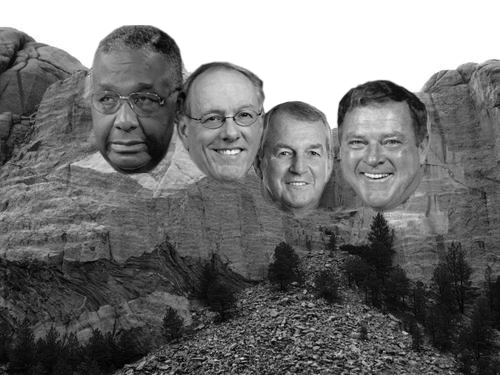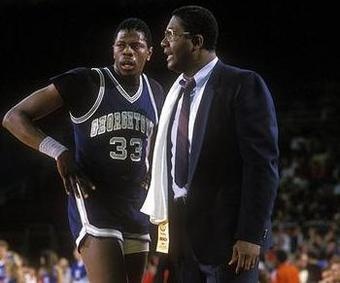Big East Mount Rushmore
Posted by Patrick Prendergast on February 22nd, 2012With all due respect to the legions of legendary players the Big East has produced in its storied history, the Big East has always been a coach’s league. This makes perfect sense given that the conference was conceived by, and molded through the eyes of a coach. It was the vision of that coach which propelled the Big East and college basketball to new heights beginning in the early 1980s. The Mount Rushmore of the Big East resides in its foundation and backbone. In many ways these are the four fathers of the conference. They all made long-term and lasting contributions to the league, and their statures grew in-kind with that of the conference as a result. These four men are your pillars.
Dave Gavitt: It is impossible to conceive any reference to the success or history of the Big East without Dave Gavitt at the forefront. A true visionary who gave life to the Big East Conference when he founded it in 1979, Gavitt relinquished a successful coaching career at Providence where he led the Friars to the 1973 NCAA Final Four to devote his attention to building the league as its first commissioner. It is hard to imagine where smaller Catholic schools like Georgetown, St. John’s, Providence , Boston College and Villanova would be today without Gavitt’s influence. He believed that there was an audience for college basketball, a belief that probably saved the relevance of college basketball in the northeast and one that transcended his league, leading to the national television attention and marketing of the sport as we currently know it.
Jim Calhoun: The long time Connecticut head coach epitomizes the tenets of the Big East. A New England-born no-nonsense guy and tireless worker who always appears ready for a challenge, Calhoun was hired by Connecticut in 1986. He has led the Huskies to three National Championships, including last season’s historic double where Connecticut came out of nowhere from a ninth-place regular season conference finish to win both the Big East and NCAA Tournaments. The Huskies have made 22 NCAA tournament appearances and four Final Fours under Calhoun’s watch. Further, in this age where football and football money are deemed king, it is important to note that Connecticut has major Division I college football today as a result of the success Calhoun and Connecticut had on the basketball court and not vice versa.
John Thompson, Jr.: Thompson coached at Georgetown for 27 seasons and was part of the Big East from day one. His rough and tumble Hoyas portrayed a bad boy image that transcended college basketball and attracted a wide ranging fanbase while giving the Big East its identity of toughness, one that remains commonly associated with the conference today. Thompson always had the courage of his convictions, a trait that could be seen in his team’s sturdy play and commitment to defense. Famous for often having a long white towel draped over his shoulder, Thompson’s sideline presence was palpable and served as an element of Georgetown’s intimidating aura. Beginning with the 1980-81 season, Thompson led the Hoyas to 16 NCAA tournament appearances in 17 years, including three Final Fours in four years highlighted by a National Championship in 1984.
Jim Boeheim: Syracuse’s iconic head coach currently resides in third place all-time on the NCAA Division I Men’s Basketball wins list with 883 victories and will likely pass Bob Knight (902, although we will never rule out a Knight comeback) for second sometime next season. Boeheim has taken the Orange to 24 NCAA tournaments and counting, winning the 2003 National Championship and making a total of three Final Four appearances. A Syracuse lifer, Boeheim’s collegiate playing days started when he walked on to the Syracuse basketball team in1962 and ended with him as captain of an NCAA Tournament team. He began his coaching career at Syracuse in 1969 and took over the head duties in 1976. Boeheim’s teams are best known for their trademark 2-3 zones that have yet to be solved. He is one of the few coaches that have been able to impose his team’s will on an opponent with a zone and perhaps, the only one to do so for such a long period of time.
HONORABLE MENTION:
Patrick Ewing*: Ewing, who played at Georgetown from 1981-85, was the face of the Big East in its early days and the conference’s first major star. The 1985 Naismith College Player of the Year, Ewing was a key part of Georgetown’s 1984 national title run and became the first ever NBA Lottery pick in 1985 and was inducted into the Basketball Hall of Fame in 2008.
Chris Mullin: Success in New York had to represent a critical factor in Dave Gavitt’s plan to create a marketable basketball conference. He had to be thrilled when Brooklyn’s own Chris Mullin suited up, and lit it up for St. John’s and helped bring them to national prominence, including a 1985 Final Four appearance. Mullin is a three-time Big East Player of the Year selection as well as a 2011 inductee to the Basketball Hall of Fame.
Lou Carnesecca: Like Boeheim and Thompson, Carnesecca is a member of the fraternity of original Big East coaches. Known for a personality as colorful as his sweaters, Carnesecca took St. John’s to 10 straight NCAA tournaments from 1982 through 1992 including a run to the Final Four in 1985
Rollie Massimino: Another original Big East coach, Massimino led Villanova to nine NCAA Tournament appearances in 11 years. Of course the most notable moment in Massimino’s career, and one of the greatest in college basketball history, was his No. 8 seed Wildcats’ improbable 66-64 National Championship victory over No. 1 Georgetown in 1985.
Rick Pitino: One of the brightest-ever stars in coaching, Pitino is an innovator who was ahead of the curve when he adapted his aggressive, pressing style to the offensive end when the three-point shot was introduced to college basketball. Pitino has taken two Big East schools, Providence and Louisville, to Final Fours and has been to five overall while winning the 1996 National Championship with Kentucky.
Troy Bell: I don’t like this any more than you do but Bell scored more points (2,632) in his career than any other Big East player while at Boston College.
2,000 Points & 1,000 Rebounds*: Anyone who scored 2,000 points and grabbed 1,000 rebounds in their career as a Big East player deserves an honorable mention. (Must have played his whole career in the Big East)
- Luke Harangody (Notre Dame)
- Derrick Coleman (Syracuse)
- Ryan Gomes (Providence)
- Danya Abrams (Boston College)
- Alonzo Mourning (Georgetown)
- John Wallace (Syracuse)
- Hakim Warrick (Syracuse)
*Ewing is also in the 2000 point, 1000 rebound club
Other Mount Rushmores:











































